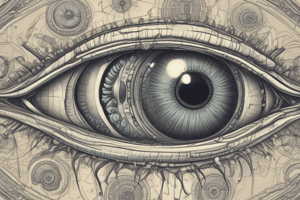Podcast
Questions and Answers
What is the primary function of the retinal pigment epithelium in relation to photoreceptor cells?
What is the primary function of the retinal pigment epithelium in relation to photoreceptor cells?
- To amplify light signals received by the cones.
- To absorb excess light and transport nutrients to the photoreceptors. (correct)
- To synthesize visual pigments within photoreceptor cells.
- To form a protective barrier preventing toxins from reaching the retina.
Which layer of the retina contains the cell bodies of the rods and cones?
Which layer of the retina contains the cell bodies of the rods and cones?
- Inner nuclear layer
- Outer nuclear layer (correct)
- Inner plexiform layer
- Ganglion cell layer
How does the retina respond to injury, such as laser irradiation, regarding its pigment epithelium?
How does the retina respond to injury, such as laser irradiation, regarding its pigment epithelium?
- Immediate loss of rod and cone functions.
- Swelling of the synapses in the outer plexiform layer.
- Decreased production of melanin granules.
- Increase in the number of phagosomes within the epithelial cells. (correct)
Which structure connects the inner and outer segments of the photoreceptors?
Which structure connects the inner and outer segments of the photoreceptors?
What is the role of the melanin granules found within the retinal pigment epithelium?
What is the role of the melanin granules found within the retinal pigment epithelium?
What comprises the outermost layer of the retina in contact with the pigment epithelium?
What comprises the outermost layer of the retina in contact with the pigment epithelium?
Which statement correctly describes the function of the retinal pigment epithelium (RPE)?
Which statement correctly describes the function of the retinal pigment epithelium (RPE)?
Which layers make up the nuclear regions of the retina?
Which layers make up the nuclear regions of the retina?
What distinguishes the fovea's anatomy compared to the rest of the retina?
What distinguishes the fovea's anatomy compared to the rest of the retina?
How does the retina respond following injury to photoreceptor cells?
How does the retina respond following injury to photoreceptor cells?
Flashcards
Retina Layers
Retina Layers
The retina is composed of three cell layers (rods and cones, bipolar cells, and ganglion cells), with their associated synapses.
Photoreceptor Cells
Photoreceptor Cells
Rods and cones—the light-sensitive cells of the retina, responsible for vision.
Rods and Cones
Rods and Cones
Specialized light-sensitive cells (photoreceptors) in the retina, distinguishing between light intensity (rods) and color (cones).
Outer Segment (Photoreceptor)
Outer Segment (Photoreceptor)
Signup and view all the flashcards
Rod Disc Renewal
Rod Disc Renewal
Signup and view all the flashcards
Photoreceptor Outer Segments
Photoreceptor Outer Segments
Signup and view all the flashcards
Retinal Pigment Epithelium
Retinal Pigment Epithelium
Signup and view all the flashcards
Rods and cones
Rods and cones
Signup and view all the flashcards
Synaptic Layers
Synaptic Layers
Signup and view all the flashcards
Inner and outer segments
Inner and outer segments
Signup and view all the flashcards
Study Notes
Chapter 1: Embryology and Anatomy
- Embryology is the development of the central nervous system from the neural groove, which forms the neural tube.
- The neural tube develops from the lateral aspect of the anterior portion of the forebrain.
- At an early stage, a thickening called the optic plate grows outwards to form the primary optic vesicle.
- The primary optic vesicle develops into the primary optic cup, eventually forming the retina.
- The neural tube develops into different structures of the eye, including the iris, ciliary body, and cornea.
- The lens develops from the surface ectoderm.
- The optic cup develops around the neural tube, and the development of the eye’s coats and orbital structures occurs due to mesoderm surrounding the optic cup.
Anatomy
- The eye's wall is made up of the cornea, (transparent outer part) and the sclera (opaque connective tissue).
- The conjunctiva (mucous membrane) covers the sclera.
- The interior of the eye includes the anterior chamber (filled with aqueous humor) and the posterior chamber (filled with vitreous humor).
- The cornea is avascular for tissue fluid nourishment.
- The aqueous humor nourishes the cornea and anterior part of the eye.
- The lens is a transparent, biconvex structure, composed of highly differentiated cells—lens fibres.
Studying That Suits You
Use AI to generate personalized quizzes and flashcards to suit your learning preferences.




